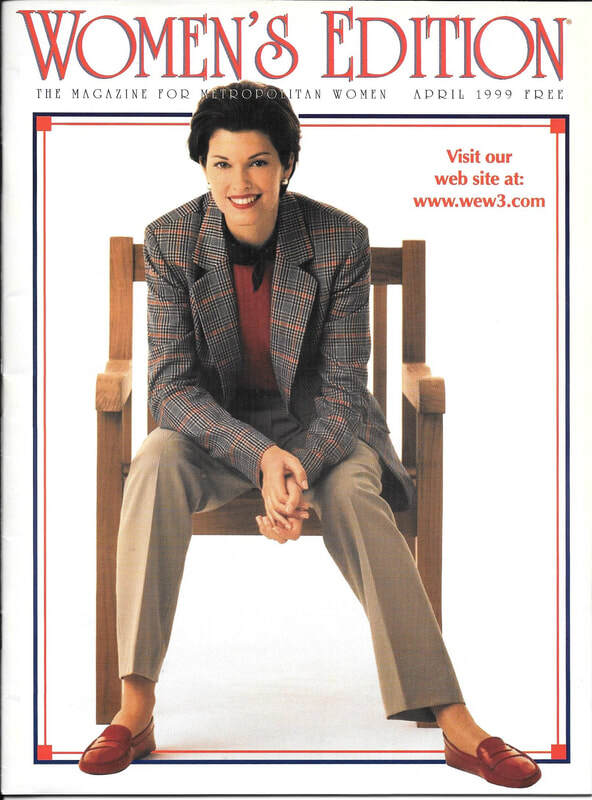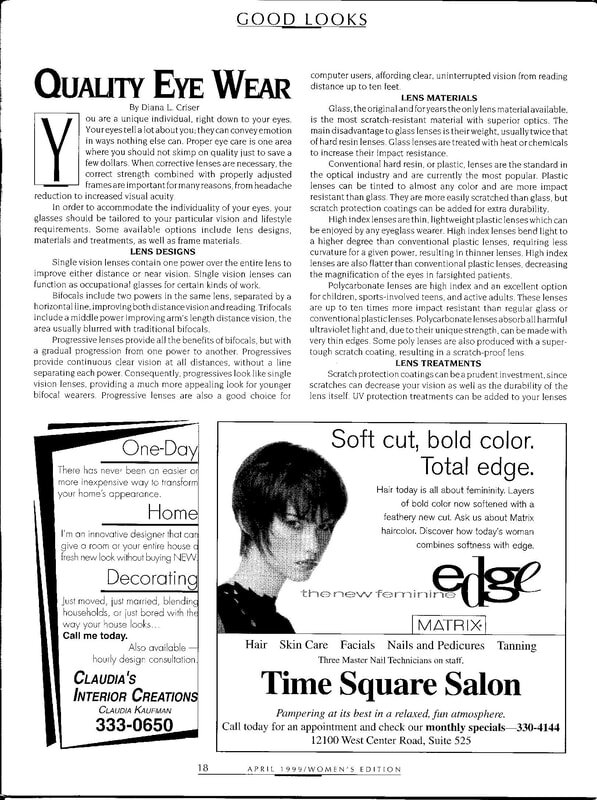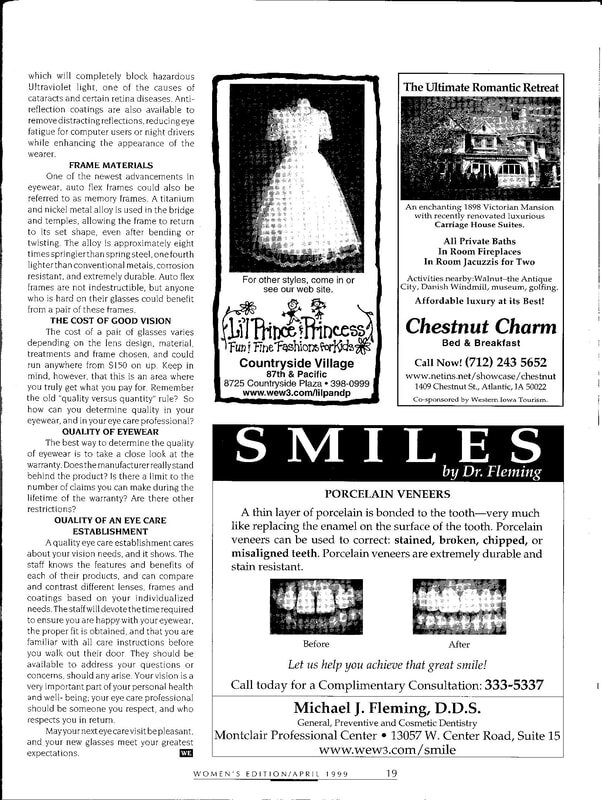Good Looks - April 1999
QUALITY EYE WEAR
By Diana L. Criser

ou are a unique individual, right down to your eyes. Your eyes tell a lot about you; they can convey emotion in ways nothing else can. Proper eye care is one area where you should not skimp on quality just to save a few dollars. When corrective lenses are necessary, the correct strength combined with properly adjusted frames are important for many reasons, from headache reduction to increased visual acuity.
In order to accommodate the individuality of your eyes, your glasses should be tailored to your particular vision and lifestyle requirements. Some available options include lens designs, materials and treatments, as well as frame materials.
LENS DESIGNS
Single vision lenses contain one power over the entire lens to improve either distance or near vision. Single vision lenses can function as occupational glasses for certain kinds of work.
Bifocals include two powers in the same lens, separated by a horizontal line, improving both distance vision and reading. Trifocals include a middle power improving arm's length distance vision, the area usually blurred with traditional bifocals.
Progressive lenses provide all the benefits of bifocals, but with a gradual progression from one power to another. Progressives provide continuous clear vision at all distances, without a line separating each power. Consequently, progressives look like single vision lenses, providing a much more appealing look for younger bifocal wearers. Progressive lenses are also a good choice for computer users, affording clear, uninterrupted vision from reading distance up to ten feet.
LENS MATERIALS
Glass, the original and for years the only lens material available, is the most scratch-resistant material with superior optics. The main disadvantage to glass lenses is their weight, usually twice that of hard resin lenses. Glass lenses are treated with heat or chemicals to increase their impact resistance.
Conventional hard resin, or plastic, lenses are the standard in the optical industry and are currently the most popular. Plastic lenses can be tinted to almost any color and are more impact resistant than glass. They are more easily scratched than glass, but scratch protection coatings can be added for extra durability.
High index lenses are thin, lightweight plastic lenses which can be enjoyed by any eyeglass wearer. High index lenses bend light to a higher degree than conventional plastic lenses, requiring lens curvature for a given power, resulting in thinner lenses. High index lenses are also flatter than conventional plastic lenses, decreasing the magnification of the eyes in farsighted patients.
Poly carbonate lenses are high index and an excellent option for children, sports-involved teens, and active adults. These lenses are up to ten times more impact resistant than regular glass or conventional plastic lenses. Poly carbonate lenses absorb all harmful ultraviolet light and, due to their unique strength, can be made with very thin edges. Some poly lenses are also produced with a super-tough scratch coating, resulting in a scratch-proof lens.
LENS TREATMENTS
Scratch protection coatings can be a prudent investment, since scratches can decrease your vision as well as the durability of the lens itself. UV protection treatments can be added to your lenses which will completely block hazardous ultraviolet light, one of the causes of cataracts and certain retina diseases. Anti-reflection coatings are also available to remove distracting reflections, reducing eye fatigue for computer users or night drivers while enhancing the appearance of the wearer.
FRAME MATERIALS
One of the newest advancements in eye wear, auto flex frames could also be referred to as memory frames. A titanium and nickel metal alloy is used in the bridge and temples, allowing the frame to return to its set shape, even after bending or twisting. The alloy is approximately eight times springier than spring steel, one fourth lighter than conventional metals, corrosion resistant, and extremely durable. Auto flex frames are not indestructible, but anyone who is hard on their glasses could benefit from a pair of these frames.
THE COST OF GOOD VISION
The cost of a pair of glasses varies depending on the lens design, material, treatments and frame chosen, and could run anywhere from $150 on up. Keep in mind, however, that this is an area where you truly get what you pay for. Remember the old "quality versus quantity" rule? So how can you determine quality in your eye wear, and in your eye care professional?
QUALITY OF EYE WEAR
The best way to determine the quality of eye wear is to take a close look at the warranty. Does the manufacturer really stand behind the product? Is there a limit to the number of claims you can make during the lifetime of the warranty? Are there other restrictions?
QUALITY OF AN EYE CARE ESTABLISHMENT
A quality eye care establishment cares about your vision needs, and it shows. The staff knows the features and benefits of each of their products, and can compare and contrast different lenses, frames and coatings based on your individualized needs. The staff will devote the time required to ensure you are happy with your eye wear, the proper fit is obtained, and that you are familiar with all care instructions before you walk out their door. They should be available to address your questions or concerns, should any arise. your vision is a very important part of your personal health and well-being; your eye care professional should be someone you respect, and who respects you in return.
May your next eye care visit be pleasant, and your new glasses meet your greatest expectations.
In order to accommodate the individuality of your eyes, your glasses should be tailored to your particular vision and lifestyle requirements. Some available options include lens designs, materials and treatments, as well as frame materials.
LENS DESIGNS
Single vision lenses contain one power over the entire lens to improve either distance or near vision. Single vision lenses can function as occupational glasses for certain kinds of work.
Bifocals include two powers in the same lens, separated by a horizontal line, improving both distance vision and reading. Trifocals include a middle power improving arm's length distance vision, the area usually blurred with traditional bifocals.
Progressive lenses provide all the benefits of bifocals, but with a gradual progression from one power to another. Progressives provide continuous clear vision at all distances, without a line separating each power. Consequently, progressives look like single vision lenses, providing a much more appealing look for younger bifocal wearers. Progressive lenses are also a good choice for computer users, affording clear, uninterrupted vision from reading distance up to ten feet.
LENS MATERIALS
Glass, the original and for years the only lens material available, is the most scratch-resistant material with superior optics. The main disadvantage to glass lenses is their weight, usually twice that of hard resin lenses. Glass lenses are treated with heat or chemicals to increase their impact resistance.
Conventional hard resin, or plastic, lenses are the standard in the optical industry and are currently the most popular. Plastic lenses can be tinted to almost any color and are more impact resistant than glass. They are more easily scratched than glass, but scratch protection coatings can be added for extra durability.
High index lenses are thin, lightweight plastic lenses which can be enjoyed by any eyeglass wearer. High index lenses bend light to a higher degree than conventional plastic lenses, requiring lens curvature for a given power, resulting in thinner lenses. High index lenses are also flatter than conventional plastic lenses, decreasing the magnification of the eyes in farsighted patients.
Poly carbonate lenses are high index and an excellent option for children, sports-involved teens, and active adults. These lenses are up to ten times more impact resistant than regular glass or conventional plastic lenses. Poly carbonate lenses absorb all harmful ultraviolet light and, due to their unique strength, can be made with very thin edges. Some poly lenses are also produced with a super-tough scratch coating, resulting in a scratch-proof lens.
LENS TREATMENTS
Scratch protection coatings can be a prudent investment, since scratches can decrease your vision as well as the durability of the lens itself. UV protection treatments can be added to your lenses which will completely block hazardous ultraviolet light, one of the causes of cataracts and certain retina diseases. Anti-reflection coatings are also available to remove distracting reflections, reducing eye fatigue for computer users or night drivers while enhancing the appearance of the wearer.
FRAME MATERIALS
One of the newest advancements in eye wear, auto flex frames could also be referred to as memory frames. A titanium and nickel metal alloy is used in the bridge and temples, allowing the frame to return to its set shape, even after bending or twisting. The alloy is approximately eight times springier than spring steel, one fourth lighter than conventional metals, corrosion resistant, and extremely durable. Auto flex frames are not indestructible, but anyone who is hard on their glasses could benefit from a pair of these frames.
THE COST OF GOOD VISION
The cost of a pair of glasses varies depending on the lens design, material, treatments and frame chosen, and could run anywhere from $150 on up. Keep in mind, however, that this is an area where you truly get what you pay for. Remember the old "quality versus quantity" rule? So how can you determine quality in your eye wear, and in your eye care professional?
QUALITY OF EYE WEAR
The best way to determine the quality of eye wear is to take a close look at the warranty. Does the manufacturer really stand behind the product? Is there a limit to the number of claims you can make during the lifetime of the warranty? Are there other restrictions?
QUALITY OF AN EYE CARE ESTABLISHMENT
A quality eye care establishment cares about your vision needs, and it shows. The staff knows the features and benefits of each of their products, and can compare and contrast different lenses, frames and coatings based on your individualized needs. The staff will devote the time required to ensure you are happy with your eye wear, the proper fit is obtained, and that you are familiar with all care instructions before you walk out their door. They should be available to address your questions or concerns, should any arise. your vision is a very important part of your personal health and well-being; your eye care professional should be someone you respect, and who respects you in return.
May your next eye care visit be pleasant, and your new glasses meet your greatest expectations.
DROP ME A LINE
Like what you see? Let's get in touch!
Diana Criser, CUA, CXA
User Experience Practitioner
Omaha, Nebraska
User Experience Practitioner
Omaha, Nebraska
402.598.4969


